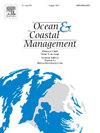广东沿海红树林优先保护区:应对气候和土地覆盖变化
IF 4.8
2区 环境科学与生态学
Q1 OCEANOGRAPHY
引用次数: 0
摘要
红树林对于减缓气候变化至关重要,但也面临着气候变化和土地覆盖变化带来的挑战。确定红树林的优先保护区并预测其对气候和土地覆盖变化的反应对于红树林应对未来的挑战至关重要。最近的研究试图确定红树林的ppa,但大多数依赖于当前和/或历史数据,并侧重于检查单个驱动因素(气候或土地覆盖变化),而忽略了对其综合影响的前瞻性评估。基于MaxEnt和InVEST集成的框架,本研究确定了受气候和土地覆盖变化影响的红树林PPAs,并通过三种共享社会经济路径(SSP)情景(SSP126:低排放情景;SSP245:中排放情景;SSP585:高排放情景)。以中国广东为例进行了实证分析。2020 - 2050年,受气候和土地覆盖变化的影响,红树林ppa在不同情景下呈现出明显的变化趋势。在SSP126情景下,购电协议预计将扩大并变得不那么分散;而在SSP245方案下,尤其是SSP585方案下,它们会收缩并变得更加分散。此外,现有海洋保护区与红树林保护区之间的一致性较低。在SSP126情景下,现有海洋保护区的有效性略有提高,但在SSP245和SSP585情景下,其有效性有所减弱。为应对气候和土地覆盖变化带来的挑战,提出了通过加强现有海洋保护区系统来保护红树林的建议。本文章由计算机程序翻译,如有差异,请以英文原文为准。
Priority protected areas for mangrove conservation in coastal Guangdong, China: Addressing climate and land cover changes
Mangroves are critical for mitigating climate change, yet face challenges from climate change and land cover alterations. Identifying priority protected areas (PPAs) for mangroves and predicting their responses to climate and land cover changes is critical for mangroves to cope with future challenges. Recent studies have attempted to identify PPAs for mangroves, but most rely on current and/or historical data, and focus on examining individual drivers (climate or land cover change), overlooking a forward-looking assessment of their combined effects. Building on a novel framework integrating MaxEnt and InVEST, this study identifies mangrove PPAs influenced by climate and land cover changes and explores their spatial-temporal variations from 2020 to 2050 through land cover dynamic prediction under three shared socioeconomic pathway (SSP) scenarios (SSP126: low-emission scenario; SSP245: mid-emission scenario; SSP585: high-emission scenario). An empirical analysis is conducted in Guangdong, China. From 2020 to 2050, mangrove PPAs exhibit distinct trends under diverse scenarios, influenced by climate and land cover changes. Under the SSP126 scenario, PPAs are expected to expand and become less fragmented; while they will contract and become more fragmented under the SSP245 scenario and especially the SSP585 scenarios. Moreover, the consistency between existing marine protected areas (MPAs) and mangrove PPAs is rather low. The effectiveness of existing MPAs demonstrates a slight improvement under the SSP126 scenario, but weaken their effectiveness under the SSP245 and SSP585 scenarios. Proposals to conserve mangroves by enhancing the existing MPA system are presented to address challenges brought by climate and land cover changes.
求助全文
通过发布文献求助,成功后即可免费获取论文全文。
去求助
来源期刊

Ocean & Coastal Management
环境科学-海洋学
CiteScore
8.50
自引率
15.20%
发文量
321
审稿时长
60 days
期刊介绍:
Ocean & Coastal Management is the leading international journal dedicated to the study of all aspects of ocean and coastal management from the global to local levels.
We publish rigorously peer-reviewed manuscripts from all disciplines, and inter-/trans-disciplinary and co-designed research, but all submissions must make clear the relevance to management and/or governance issues relevant to the sustainable development and conservation of oceans and coasts.
Comparative studies (from sub-national to trans-national cases, and other management / policy arenas) are encouraged, as are studies that critically assess current management practices and governance approaches. Submissions involving robust analysis, development of theory, and improvement of management practice are especially welcome.
 求助内容:
求助内容: 应助结果提醒方式:
应助结果提醒方式:


